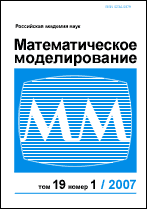|
This article is cited in 2 scientific papers (total in 2 papers)
The boundary conditions in the bicompact schemes for HOLO algorithms for solving the transport equation
E. N. Aristovaa, N. I. Karavaevaba
a Keldysh Institute of Applied Mathematics RAS
b Moscow Institute of Physics and Technology
Abstract:
The paper considers bicompact schemes for HOLO algorithms for solving the transport equation. To accelerate the convergence of scattering iterations, not only the solution of the transfer equation with respect to the distribution function of high order (HO) is used, but also the quasidiffusion equation of low order (LO) is used. For both systems of kinet-ic equations semi-discrete bicompact schemes with the fourth order of approximation in space are constructed. Integration over time can be carried out with any order of approx-imation. The diagonal-implicit third order approximation method is used in the work, its each stage can be reduced to the implicit Euler method. The discretization of quasi-diffusion equations is described in detail. Two variants for the boundary conditions for the LO part are considered: the classical one using fractional-linear functionals for the flux and radiation density ratio, and also by the radiation density value from the HO part of the system. It is shown that the classical boundary conditions for the LO system of equations of quasi-diffusion reduces the order of convergence of the scheme in time to the second. Setting the boundary conditions under the solution of the transport equation preserves the third order of convergence in time, but worsens the efficiency of iteration acceleration in HOLO algorithm.
Keywords:
transport equation, quasi-diffusion method, bicompact scheme, HOLO algorithms for transport equation solving, sweep method, diagonally implicit Runge-Kutta method.
Received: 11.03.2019
Revised: 11.03.2019
Accepted: 08.04.2019
Citation:
E. N. Aristova, N. I. Karavaeva, “The boundary conditions in the bicompact schemes for HOLO algorithms for solving the transport equation”, Matem. Mod., 31:9 (2019), 3–20; Math. Models Comput. Simul., 12:3 (2020), 271–281
Linking options:
https://www.mathnet.ru/eng/mm4107 https://www.mathnet.ru/eng/mm/v31/i9/p3
|

|




 Contact us:
Contact us: Terms of Use
Terms of Use
 Registration to the website
Registration to the website Logotypes
Logotypes







 Citation in format
Citation in format 
